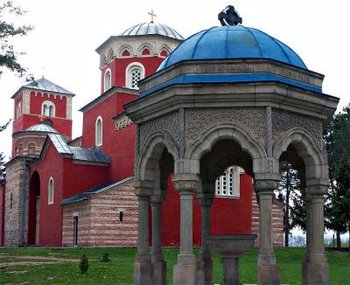Difference between revisions of "Zica Monastery (Serbia)"
m (copyedit) |
m (repetition of "remaining" in the sentence) |
||
| Line 7: | Line 7: | ||
==Architecture== | ==Architecture== | ||
| − | Zica is built according to the Raska school in the Romanesuque style. The monastery was originally painted red in the tradtion of the Mount Athos monasteries. There are few | + | Zica is built according to the Raska school in the Romanesuque style. The monastery was originally painted red in the tradtion of the Mount Athos monasteries. There are few frescoes dating back to the 13th century remaining in the lateral choir recesses. Most of those existing today date from the early 14th Century. The Church of the Ascension of our lord is a single nave church build in four sections, the third rising up to a high octagonal dome. |
==See also== | ==See also== | ||
Revision as of 14:51, April 23, 2006
History
The monastery was founded by King Stefan Prvovencani, the First-Crowned, and built in the early 13th century and received St. Sava as the first Patriarch of the Serbian Orthodox Church in 1219. The monastery was burned in a raid near the end of the 13th century and was subsequently deserted. Multiple renovations were carried out during the late 13th and early 14th centuries. The most complete renovations were completed during the rein of King Milutin (1282-1321).
Nikolai Velimirovic was consecrated Bishop of Zica in 1919. Zica suffered damage during World War II which Bishop Nikolai was unable to restore, because of his arrest there in 1941. After the war Zica became a woman's monastery. Zica celebrated its 800th anniversary in 2005.
Architecture
Zica is built according to the Raska school in the Romanesuque style. The monastery was originally painted red in the tradtion of the Mount Athos monasteries. There are few frescoes dating back to the 13th century remaining in the lateral choir recesses. Most of those existing today date from the early 14th Century. The Church of the Ascension of our lord is a single nave church build in four sections, the third rising up to a high octagonal dome.
